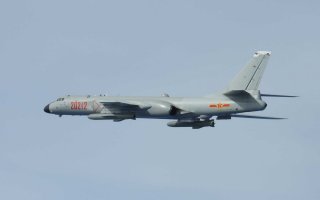China Has It’s Own Version of the B-52 Heavy Bomber (Kind Of)
Meet the H-6K.
Here's What You Need to Know: A long-range bomber is only as good as the intelligence that tells it where to strike.
Today just three countries operate long-range heavy bombers. Russia has 170 or so Bears, Backfires and Blackjacks. America fields 160 swing-wing B-1s, radar-evading B-2s and stalwart B-52s.
China’s bomber force is smaller with around 130 H-6s. And most of the H-6s, copies of Russia’s Cold War Tu-16, lack the long range and heavy payload that many of the Russian and American bombers boast.
But that’s changing. After years of work, the Chinese air force has reportedly outfitted two regiments—together possessing around 36 bombers — with a new, much more capable “K” version of the H-6.
The H-6K is Beijing’s B-52 — a far-flying, fuel-efficient heavy bomber combining a simple, time-tested airframe with modern electronics and powerful, precision weaponry. Although to be fair, the B-52 flies much farther with more bombs and missiles.
Still, over the vast Pacific Ocean, where the tyranny of distance prevents most aircraft from operating efficiently, the H-6K could prove to be one of China’s most important planes in wartime.
But the H-6K could have a big weakness — one that actually has little to do with the bomber itself.
Tupolevs forever
The H-6K is a 21st-century version of a Soviet bomber that first flew in April 1952. The Tupolev design bureau’s Tu-16 was the Soviet Union’s first big, jet-propelled bomber. Powered by two AM-3 turbojets buried in the wing roots, the subsonic Tu-16 could haul up to 10 tons of bombs — nuclear or conventional.
With a standard bombload and no aerial refueling, a Tu-16 could fly more than 1,000 miles before needing to turn back.
The Tu-16, which NATO called “Badger,” proved to be a solid, reliable airplane, much like the United States’ B-52, which first flew in 1954 and, with lots of upgrades, is still going strong.
Moscow quickly developed different versions of the Tu-16 for reconnaissance, electronic warfare, aerial refueling and to haul cruise missiles for attacks on U.S. Navy aircraft carriers.
Faster and more modern Tu-22Ms and Tu-160s — NATO designations “Backfire” and “Blackjack,” respectively — replaced the Badgers as the Cold War ended. But the Tu-16 soldiered on … in China.
Beijing’s heavy bomber
China bought the rights to the Tu-16 in the late 1950s. Over the next 60 years, state-owned manufacturer Xian churned out nearly 200 copies of the redesignated H-6.
Like the Soviets, the Chinese modified the basic, four-person H-6 for a wide range of missions. The H-6A was an atomic bomber. The H-6B was a recon plane. The H-6C was a conventional bomber. There’s an H-6U tanker version. The H-6H, M and K models carry cruise missiles.
But until the H-6K first flew in 2007, all of Beijing’s bombers were still 1950s-vintage Tu-16s in their guts. Swapping old engines and electronics for modern gear, the H-6K represents a huge evolutionary leap over the old Xian bombers.
The H-6K replaces the original AM-3 turbojets — which one analyst called “thirsty and maintenance intensive by current standards” — with much more efficient D-30 turbofans. Without aerial refueling, an armed H-6K can cruise 1,900 miles or so before needing to turn around — a big improvement over older models.
Even more impressive, an H-6K that refuels in mid-air twice can reportedly range 3,100 miles from base while hauling 12 tons of weapons, including up to six YJ-12 supersonic anti-ship missiles or CJ-20 subsonic land-attack cruise missiles, capable of striking targets 250 and 1,500 miles away, respectively.
Supported by tankers, an H-6K armed with YJ-12s or CJ-20s could venture deep into the Pacific, hunting for American ships or even flying within striking distance of America’s own main bomber outpost in Guam, some 3,000 miles from the Chinese mainland.
“That is, if it can slip through air defenses,” analyst Hans Kristensen pointed out. But Jon Solomon at Information Dissemination assumed Chinese fighters would accompany the bombers in order to protect them. “H-6Ks can be escorted thousands of miles out to sea by J-11s,” Solomon wrote.
Targeting dilemma
But it’s not enough to just safely fly that far. Long-range strikes — especially against moving ships at sea — require careful planning and precise targeting. The H-6K sports a new nose radome housing a modern air-to-ground radar, which might help guide a YJ-12 but undoubtedly lacks the power to spot targets for a CJ-20.
Instead, the CJ-20 probably requires mission planners to pre-load precise coordinates into the missile’s computer prior to launch. The YJ-12 has its own seeker but the bomber needs to lob the missile into the right general area for the munition to have any chance of detecting and hitting a ship.
“It is not clear whether China has the capability to collect accurate targeting information and pass it to launch platforms in time for successful strikes in sea areas beyond the first island chain” — that is, a couple thousand miles from the Chinese coast, the Pentagon explained in its 2013 report on China’s military.
Targeting, more than the physics of flight and fuel consumption, is likely the current practical limit on the H-6K’s reach, and thus its wartime usefulness to Chinese commanders.
In battle, a long-range bomber is only as good as the intelligence that tells it where to strike. And when it comes to intel for bomber raids, China might not be quite ready to steer its new H-6Ks.
Just wait. According to William Murray from the U.S. Naval War College, “it seems reasonable to assume that China has assessed what is necessary and is investing aggressively to satisfy those requirements.”
David Axe served as Defense Editor of the National Interest. He is the author of the graphic novels War Fix, War Is Boring and Machete Squad.
This article first appeared in 2015.
Image: Wikimedia Commons

